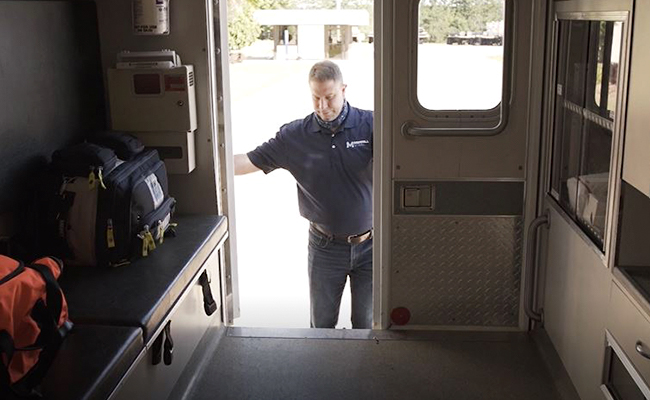
Driving Value: Creating a Mobile Health Clinic En Route to $4 Million in Savings
The Alliance awarded Matt Ohrt, VP of HR and Medical Services at Merrill Steel. External Link. Opens in new window., with a Health Transformation Award on Oct. 1, 2020, in recognition of significantly improving his community’s access to high-value health care by creating an on-site and mobile health clinic. The Alliance created a case study capturing Matt’s journey so other employers can emulate his success. This article is a condensed version of the case study.
PLANTING THE SEEDS OF CHANGE
Matt first started down the path of creating a clinic after some internal discussions within Merrill Steel after seeing just how poorly Wisconsin compared to other states in terms of health costs.
“We learned that Wisconsin is the second-highest state for health care costs, so it kind of becomes a necessary action when you see the disparity from, say Michigan, that’s averaging about 150% of Medicare, while Wisconsin is averaging 400% of Medicare.”
Matt was likely referring to RAND Corporation’s Hospital Price Transparency Study, which used claims data to compare hospital prices paid for by privately insured patients as a percentage of Medicare.
Once he understood how damaging the cost of health care was to his community, Matt began working to improve the quality and accessibility for his nearly 500 employees by implementing a direct primary care clinic on-site.
DIGGING DEEP FOR FUTURE SAVINGS
It would not be easy. They needed a state permit to recreate the space and received two commercial bids for the project – the cheaper of which came in at $370,000.
“We thought, ‘Boy, we could build something for that,’ but we really wanted it to be on-site.” So Matt decided to take matters into his own hands – quite literally – and went to Merrill Steel’s ownership with an unusual proposal.
“After the second commercial bid, I looked at one of the owners and said, ‘I have a background in general contracting. I can find subcontractors and manage this process for us.”
Matt did general contracting for seven years throughout his college career, and with ownership’s blessing, he used that experience to assemble his team and started building the on-site health clinic completely in-house.
THE FRUITS OF LABOR
When it was all said and done, Merrill Steel’s initial, up-front investment totaled a quarter of a million dollars – all before they saved a single cent.
However, Matt quickly rewarded the ownership’s faith in him by providing a quick return on their investment.
“We’re self-insured, and we’re spending over $5 million on health care, writing checks for stop-loss insurance, etcetera – so cost was a big factor for us,” Matt explained. “We were seeing 9% cost increases year after year, but since 2016 we’ve saved $4 million.”
THE DOCTOR IS IN
But Matt didn’t stop there. Once Merrill Steel started realizing big savings from the on-site clinic, they were able to focus on other areas they could save, too.
A large portion of Merrill Steel’s health care costs were being spent on expensive imaging services like MRIs, ultrasounds, and X-rays, and considering how rough-and-tough the nature of steelwork can be, those stats are not unique – but how Matt solved it was.
He bought and refurbished an old ambulance, transforming it into a mobile health clinic that makes house calls.
DRIVING TOWARDS HIGH-VALUE HEALTH CARE
Giving new meaning to direct primary care, the mobile health clinic provides special accessibility to health care services and saves Merrill Steel and its employees on health care costs by avoiding urgent care and emergency room services. It’s a convenient vehicle for prescription medications, injury treatment, and is even outfitted with a mobile X-ray machine.
Merrill Steel offers some incredible services at their on-site clinic, too – IVs, lab work, casting services, suturing, MRIs, X-rays, and physical therapy – and all at equivocal or lower costs than what their local health systems charge. The clinic can also prescribe, saving employees time and money to fill prescriptions without the cost or hassle of additional office visits.
GAINING EMPLOYEE “BUY-IN”
However, having great access to a top-of-the-line on-site clinic doesn’t necessarily translate to better health care and more savings – employees need to use the resources they offer.
“We have around 600 members with a 60-70% participation rate, so gaining more participation is still an opportunity for us,” explained Matt.
Building trust and getting a hardworking, salt-of-the-earth type workforce takes time, educational resources, and constant communication. Merrill Steel made a deliberate decision to promote constant contact between their employees and their clinic provider, Astia Health.
“Every year we have Astia Health come to our Christmas party and our Family Fun Day,” Matt explained. “But on a day-to-day basis, we encourage them to walk around the office and interact with and be one of us.”
RELATIONSHIPS: THE CORE OF PRIMARY HEALTH CARE
Those contact opportunities warm up employees to visiting the clinic, where the real relationship-building happens.
“We wanted the clinic to be relationship-focused from the get-go so employees would feel comfortable, and they don’t open up to that provider in a rushed, 15-minute appointment,” Matt explained, “but when you can spend 60 minutes talking with an NP, you begin to trust that person and can open up and ask for help.”
NEXT STEPS FOR MERRILL STEEL
Matt emphasized that not everything happened at once and that there’s always room for improvement. They started with a vision to build an on-site clinic, which they periodically upgraded, and it all eventually led them to create a mobile health clinic. So, what’s next?
“We have some big goals ahead of us, including expanding the mobile health clinic’s hours, benefit plan design and revising our wellness program to offer significant dollar contributions to employee HSAs. We’re going to do a lot more direct contracting and allow employees to shop for healthcare in a free-market atmosphere by guiding and incentivize employees and their families to go to providers that are – one, providing high- quality care, and two, that are transparent and competitive in their price.”
Matt and his team plan to add chiropractic services to their top tier of The Alliance Premier Network. That means free adjustments for employees and their families while preventing expensive and painful surgeries.
A LEADER OF HEALTH CARE INNOVATION FOR WISCONSIN
Shortly after Matt received a Health Transformation Award from The Alliance, he accepted the Employer/Purchaser Excellence Award. External Link. Opens in new window. on his employer’s behalf from The National Alliance of Healthcare Purchaser Coalitions. External Link. Opens in new window.. Previous winners of the award include some big names like Walt Disney, Wal-Mart, and another employer of The Alliance – Brakebush Brothers, Inc.
“I’m not motivated by awards,” said Matt. “We’re the second-to-highest cost state for health care in the nation, so there’s good motivation for me to help people – but also to help our companies survive and prosper and be competitive in the marketplace.”
[/et_pb_text][/et_pb_column][/et_pb_row][/et_pb_section]







